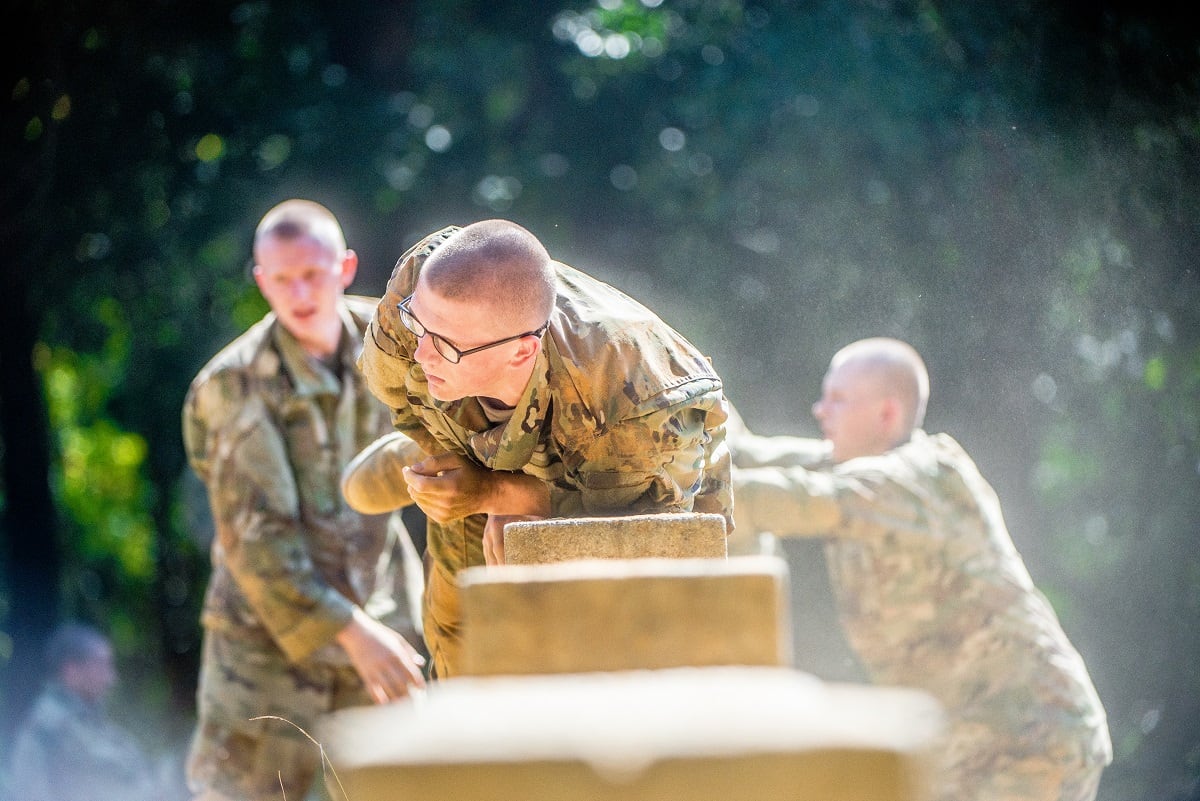A 21st century approach to training new infantry and armor soldiers now includes an early understanding of the legacy they’ll carry and the kind of warfighter they’ll be 22 weeks later.
The infantry is calling its event “The First 100 Yards,” an homage to their lineage of closing the last 100 yards of the fight, while the armor community has drawn from the Iraq war with its “Thunder Run” to get new soldiers rolling.
The changes sparked fair amounts of snark online, with many focusing on the end of “shark attacks” in which drill sergeants, for the past several decades, have swarmed stragglers in a blitz of pressure in the first minutes and hours of training, to shock them into submission.
RELATED

But the generals heading the infantry and armor schools, as well as their senior enlisted, see that take as shortsighted, missing the advances in training, soldier and leader development that the Army is pursuing.
In an interview with Army Times, Brig. Gen. David Hodne, Infantry School commandant and director of the Soldier Lethality Cross-Functional Team, pointed to the school’s patch and motto as a clear indicator of the intent of training.
That patch has an M1905 bayonet, and the motto is “Follow Me.”
“Follow me, it’s easy to say, hard to do,” Hodne said.
That’s the first instruction an infantry sergeant should be giving a new soldier.
“It doesn’t say, ‘do as you’re told,’” Hodne added.
Brig. Gen. Kevin Admiral told Army Times that the “Thunder Run” initiation for Armor School soldiers will focus on “teamwork from the very beginning.”
“From the very first day they come here, they’re part of a scout squad, a tank crew,” he said. “They’re going to be part of a team that demands success.”
Hodne and Admiral both pointed out that the shark attack method was a relic from the draft-era Army.
“This is a new time for our Army, and we need to move forward to something different,” Admiral said.
In a talk during the annual Maneuver Warfighter Conference in September, the Infantry School’s Command Sgt. Maj. Rob Fortenberry drew a distinct line, describing the shark attack method as a way that drill sergeants used to “establish dominance and authority using intimidation and fear to weed out the weak of heart.”
This, coupled with drill sergeants singling out underperforming soldiers with mass attacks, was supposed to assess a new soldier’s ability to handle stress.
“This activity does not instill the spirit of the infantry,” Fortenberry said.
Both Hodne and Fortenberry say the new event focuses instead on the “spirit of the bayonet,” outlined by Gen. George C. Marshall in FM23-25, the field manual published in 1943 in the midst of World War II. The manual drew inspiration from Marshall’s time in the trenches during World War I.
“The will to meet and destroy the enemy in hand-to-hand combat is the spirit of the bayonet," Marshall wrote. “It springs from the fighter’s confidence, courage and grim determination, and is the result of vigorous training. Through training, the fighting instinct of the individual soldier is developed to the highest point.”
To do that, Hodne said, the cadre is using a phased approach, early in the training process, that develops teamwork, identifies informal leadership, establishes trust and builds esprit de corps.
As Fortenberry explained in his presentation, the five-phase approach begins with a series of questions and answers for the new soldiers, the battalion and company mottos, the unit chain of command and unit history.
In phase two, they’ll conduct a resupply mission, each platoon getting a mission order and conducting the tasks. By phase three they will compete in Army Combat Fitness Test events, the leg tuck, pushups and standing power throw. Each member will do as many reps as possible. The combined total in the fastest time will decide a group winner.
The remaining groups will do corrective training exercises before being quizzed on the information they learned in phase one.
Then they’ll be instructed on identifying equipment and correctly placing equipment in a designated staging area. They’ll be graded. Attention to detail is key.
In phase four, the soldiers meet the training cadre and witness an infantry demonstration of graduating soldiers who’ve completed the 22-week One Station Unit Training. That way, Fortenberry said, they’ll see what they’re aiming to become.
Finally, in phase five, each platoon moves to its respective area for the first 72 hours of red cycle training and the infantry selection process.
“The aim for instructors and commanders is clear — that (soldiers) believe they’ve got the skill and will to accomplish the missions we’re going to assign them,” Hodne said. “They also believe in their teammates.”
“A soldier fell out in a shark attack, the only people who came to that soldier’s aid were the drill sergeants,” Hodne said. “The soldiers didn’t come help, they were just glad they weren’t the ones being attacked.”
That kind of thinking must change, he said.
Drawing again from Marshall, Hodne quoted the general’s key advice to Army training instructors: “Avoid boisterous bullying” and “impatient methods.”
Now, 77 years later, that advice will be heeded.
Todd South has written about crime, courts, government and the military for multiple publications since 2004 and was named a 2014 Pulitzer finalist for a co-written project on witness intimidation. Todd is a Marine veteran of the Iraq War.





